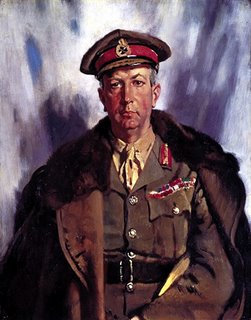Tuesday, November 07, 2006
WEEK OF REMEMBRANCE - CANADA'S HUNDRED DAYS
 "one of the finest feats in our history."
"one of the finest feats in our history."
- Lieutenant General Sir Arthur Currie (pictured), describing the Canadian Corps's breach of the Hindenburg Line
Canada's Hundred Days
Dates: 8 August 1918 - 11 November 1918
The Cost:
First day, Battle of Amiens
Canadian casualties - 4,109; 1,306 dead
Total:
Casualties of the Canadian Corps - 30,802
Summary:
Beginning with the Battle of Amiens on 8 August 1918 the entire Canadian Corps, fighting together, spearheaded one of the major offences of the allied march to victory. At Amiens, Canadian and Australian divisions executed a complete surprise attack on the German lines. On the first day, the Second Canadian Division advanced an incredible thirteen kilometers. The battle was a turning point; German Chief of Staff General Ludendorf later referred to August 8th as "the black day of the German army in the history of this war."
With the success at Amiens the Canadian divisions were shifted to Arras to attack the Hindenburg line, the principal German line of defence. Between 26 August and 2 September the Canadians attacked the line continuously and relentlessly and broke the crucial Drocourt-Queant portion of the line just in front of the Canal du Nord suffering 11,400 casualties including the wounded future Governor General Major Georges Vanier.
At this point General Currie, commanding the Canadian Corps, rested his troops and prepared a plan to cross the Canal du Nord. Currie's plan was so audacious that it required the approval of British Commander in Chief General Sir Douglas Haig. On 27 September the entire Canadian Corps with an attached British division were channeled through a 2,600 yard dry gap of the Canal du Nord and breached three lines of German defences.
On the strength of these victories the Canadians advanced steadily. The Germans continued to mount fierce defences but the Canadians and the rest of the allies were now inflicting losses that could not be recovered. The Canadian Corps captured Cambrai, Valenciennes, and Mons before the armistice on 11 November. Following the armistice Canadian troops crossed the Rhine to contribute to the occupation of German, and in Bonn General Currie was recognized on behalf of the Canadian achievements.
The Result:
In short - Victory. Hardened by their losses at the Somme, united by success at Vimy, and fighting under their own commander, General Currie, the Canadian Corps played a major roll in smashing the final defences of the Germans. The final months of fighting came at significant cost, as the Canadians suffered nearly half of their total casualties of the war.
Sources:
For more detail, interpretation, or reference see the following sources.
FirstWorldWar.com - The Canadian Expeditionary Force
Department of Veterans Affairs - Canada's Hundred Days
National Archives of Canada - The Last 100 Days
National War Museum - Canvas of War
Morton, Desmond. "A Military History of Canada." Toronto: McCllelland & Stewart Inc, 4th ed. 1999. pp. 163-5.
Read or Post a Comment
<< Home